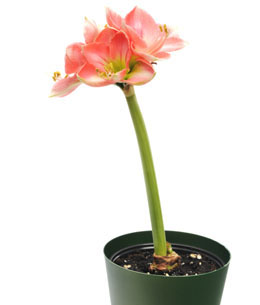Amaryllis bulbs can be grown successfully in gardens as well as pots. This article provides the instructions and care needed for growing these bulbs.

Amaryllis (scientific name
Amaryllis belladonna) is a bulbous plant, commonly planted for its magnificent, bell-shaped flowers (more than 10 cm diameter). It can grow up to 50-60 cm in height; the leaves are strap-shaped (30-50 cm long and 2-3 cm wide). A flowering stalk bears about 2-12 flowers. Due to the morphological similarity of Amaryllis flowers with lilies, the plant is commonly known as Belladonna Lily or Jersey Lily.
Amaryllis is known to have been cultivated as early as the 18th century. The most widely cultivated Amaryllis varieties include white, pink, and red flowers. Early blooming Amaryllis produce flowers during December, whereas other late varieties may flower in January and/or February.
Growing Instructions and Care
Amaryllis plants, due to their large flowers and ease of plantation, are a preferable choice for gardening. The bulbs can be planted either way, as garden plants or potted plants. In the former case, they are used as specimen plants or border plants. In some cases, Amaryllis bulbs are planted in greenhouses to meet the plant requirements. While selecting the bulbs, make sure you purchase the superior quality ones, without new leaves. Studies have shown that these bulbs, if maintained properly, can bear flowers for as long as 75 years.
Growing in Containers
If you are planning to grow these bulbs as a part of container gardening, then prepare a soil mixture consisting of equal parts of loam, sand, and organic matter. The ideal time for planting in pots is in the month of October; however, plantation can be done anytime after the dormant period. Since Amaryllis bulbs grow well in slightly-acidic soil (pH 6.0 to 6.8), make sure the soil mixture pH is of that range. Fill this soil mixture in shallow and small pots (diameter 5 inches) to about ⅔
rd of the pot depth. For proper drainage of water, add gravel (about ½ an inch) at the base of the pots. While potting the bulb, cover half of it with soil.
Growing in Gardens
Late September is the ideal time for growing Amaryllis bulbs in flower gardens. For growing in gardens, prepare an elevated soil bed as you do for other plants. You can enrich the soil by mixing it with organic compost. These plants can grow well in any type of well-drained garden soil. Maintain a gap of about 12 inches between two bulbs for proper development of each plant. Placing the bulbs is similar to potting; you should cover the bulbs halfway with soil. It is advisable to mulch the soil bed to conserve soil moisture and control weeds.
After potting or planting in gardens, regular watering should be done for the proper establishment of the Amaryllis bulbs. Amaryllis usually bloom for 6-8 weeks after potting and/or planting in the gardens.
Flowering and Aftercare
As flowering starts, the Amaryllis plants should be provided maximum sunlight and enough water. When the flowering stalk reaches a height of about six inches, enrich the soil by applying fertilizers (preferably low in nitrogen). This will increase the flower size and brightness of the flower color. You can remove the flowers as they fade, to avoid seed formation. During flowering, you can notice the bulbs shrink.
Water and fertilize the plants even after the blooming period is over to enhance the leaf and bulb growth. A large bulb can produce about three flowering stalks. In summer, you can maintain a semi-shade condition and provide water at regular intervals. By September, the leaves of the Amaryllis plants dry completely, leaving only the bulbs. The resulting Amaryllis bulbs should be kept in a cool and dry condition. Watering should be stopped to prevent rotting of the bulbs, until there are signs for regrowth. You can make the bulbs bloom in the same location or repot them as per your convenience.






 Amaryllis (scientific name Amaryllis belladonna) is a bulbous plant, commonly planted for its magnificent, bell-shaped flowers (more than 10 cm diameter). It can grow up to 50-60 cm in height; the leaves are strap-shaped (30-50 cm long and 2-3 cm wide). A flowering stalk bears about 2-12 flowers. Due to the morphological similarity of Amaryllis flowers with lilies, the plant is commonly known as Belladonna Lily or Jersey Lily.
Amaryllis (scientific name Amaryllis belladonna) is a bulbous plant, commonly planted for its magnificent, bell-shaped flowers (more than 10 cm diameter). It can grow up to 50-60 cm in height; the leaves are strap-shaped (30-50 cm long and 2-3 cm wide). A flowering stalk bears about 2-12 flowers. Due to the morphological similarity of Amaryllis flowers with lilies, the plant is commonly known as Belladonna Lily or Jersey Lily.